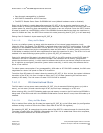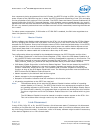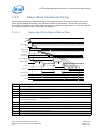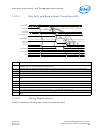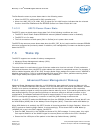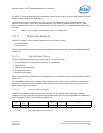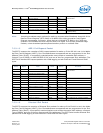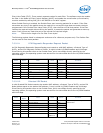
Wake Up — Intel
®
82575EB Gigabit Ethernet Controller
324632-003 Intel
®
82575EB Gigabit Ethernet Controller
Revision: 2.1 Software Developer’s Manual and EEPROM Guide
January 2011 231
The SerDes also enters a power-down state in the following cases:
• When the 82575 is configured for PHY operation only.
• When the LAN0_DIS_N (or LAN1_DIS_N) signal for this LAN function indicates that the relevant
function should be disabled and the EEPROM SerDes Low-Power Enable bit is set.
7.4.3.2 82575 Power-Down State
The 82575 enters a global power-down state if all of the following conditions are met:
• The 82575 Power-Down Enable EEPROM bit was set (default hardware value is disabled).
• The 82575 is in Dr state.
• The link connections of both ports (PHY or SerDes) are in power down mode.
The 82575 also enters a power-down state when the DEV_OFF_N pin is active and the relevant EEPROM
bits were configured as previously stated. In addition, the manageability firmware can decide to power
down the 82575.
7.5 Wake Up
The 82575 supports two modes of wakeup management:
1. Advanced Power Management wakeup (APM).
2. ACPI/PCIe* defined wakeup.
The usual model is to activate only one of the two modes at a time but not both. If both modes are
activated at the same time, the 82575 might wakeup the system in unexpected events. For example, if
APM is enabled together with PCIe* PME, a magic packet might wakeup the system even if APMPME is
disabled, alternatively, if APM is enabled together with some PCIe* filters, packets matching these
filters might wakeup the system even if PCIe* PME is disabled.
7.5.1 Advanced Power Management Wakeup
Advanced Power Management Wake Up, or APM Wake Up, was previously known as Wake on LAN
(WOL). It is a feature that has been present in the 10/100 Mb/s NICs for several generations. Its basic
function is to receive a broadcast or unicast packet with an explicit data pattern and respond by
asserting a wake-up signal to notify the system about a wake-up event. In the earlier generations, this
was accomplished by using a special signal that ran across a cable to a defined connector on the
motherboard. The adapter asserted the signal for approximately 50 ms to signal a wake up. If the
82575 is configured appropriately, it uses an in-band PM_PME message to achieve this.
At power up, the 82575 reads the APM Enable bits from the EEPROM Initialization Control Word 2 into
the APM Enable (APME) bits of the Wakeup Control Register (WUC). These bits enable APM Wake Up.
When APM Wake Up is enabled, the 82575 checks all incoming packets for Magic Packets*. When the
82575 receives a matching Magic Packet, it acts accordingly. If the Assert PME on APM Wake Up
(APMPME) bit is set in the WUC register, the 82575:
• Sets the PME_Status bit in the PMCSR and issues a PM_PME message. In some cases, this might
first require assertion of the WAKE# signal to resume power and clock to the PCIe* interface.
• Stores the first 128 bytes of the packet in the Wake Up Packet Memory (WUPM).



